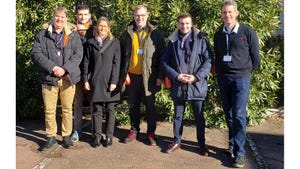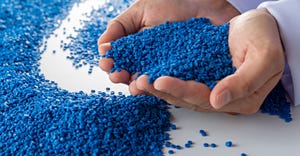IMM's Plant Tour: The micromolding super-express
December 3, 1999
Akiji Kamiya’s father hand-crafted ceramic pots for bonsai trees. In 1942, Kamiya’s father started a small metal stamping shop to serve the Japanese market for small precision watch parts and to send his sons to school. Kamiya took his heritage of precision craftsmanship, a belief that the key to success in business lies in encouraging employee innovation, and added modern, leading-edge manufacturing technologies. He leveraged it all into building a vertically integrated, full service, family run multinational corporation—the Sansyu Group of companies—the biggest custom micromolder and micromoldmaker in the world.
Kamiya and company have been and continue to be micromolding pioneers. Here are just a few of the results of Sansyu’s pioneering efforts:
A 1.11-by-.96-by-.64-mm thread-winding bobbin, weighing .3 mg; a tiny circular part with 80 precisely spaced .10-mm (±.01 mm) radial cuts.
Parts smaller than the head of a fountain pen with 24 holes placed in two lines, each hole diameter measuring .23 mm (±.01 mm).
Gears with an OD of 2.6 mm (±.03 mm) with 24 teeth; Jigma Class 0 gears, the Japanese gear industry’s highest quality rating.
Parts with multimolded two-color .25-mm-thick lettering (±.02 mm); small three-color multimolded parts.
A mold with 24 moving components that ejects small vented cylindrical parts with 360° core movement; uncomplicated, horizontally shuttling two-shot molds.
If there is any contribution that can be singled out of Kamiya’s legacy as being the most important, it must be his commitment to automating mass production. Like the Japanese bullet train—the Shinkansen super-express—Sansyu’s automated factories race along around the clock, quickly and efficiently producing millions of micron-tolerance parts and metal/plastic assemblies of consistent quality that arrive at customers, like the Shinkansen, right on time.
Some of the world’s biggest automotive and office equipment OEMs are sourcing parts from Sansyu’s wholly owned factories in Hong Kong and Indonesia, from its offices in Singapore, from its strategic ally—Makuta Technics—in the U.S., or from its manufacturing complex in Japan. Regarding the latter, you’ve got to see it to believe it. The Sansyu Shinkansen is about to depart. All aboard! Let’s tour.
Sansyu Finetool
Sansyu’s global headquarters and main manufacturing complex is in the Kamiya family’s hometown of Takahama-City in the Aichi prefecture. In fact, Kamiya’s father’s 50-year-old home is on the grounds. Another Sansyu manufacturing facility is in nearby Handa City. Sansyu calls its operations Sansyu Microtechnics. Like many Asian plants, Sansyu Microtechnics mostly sprawls vertically. But it fits a lot into the floors of its buildings.
A tour of Sansyu Microtechnics begins where it all starts in molding—the toolroom. Masayuki Suzuki is president of Sansyu Finetool, Sansyu’s spotless, fully air-conditioned moldmaking division. In addition to being Kamiya’s son-in-law, Suzuki is a nuclear physicist with a doctorate in EDM.
Sansyu Finetool produces 50 tools a month, mostly in D-2 steel. Lead time for single-shot tooling is eight weeks. Everything is done in-house from heat treating and copper electrodes to fixtures and mold bases. Three presses are reserved for mold tryouts.
Sansyu Finetool is 100 percent DNC and runs 24/7 with only one manned shift. Its capacity includes two high-speed Makino Hyper 5 machining centers, two of only 150 in the world, accurate to 5 µm. Programs are downloaded, literally, from a room upstairs on the third floor.
Super-express Moldmaking
Upstairs, Yoshihiro Shimada, vp, presides over four seats of 3D Unigraphics and 20 seats of 2D Seiko Epson that are used to help customers design parts and to write new programs. The design room is interactively networked to Sansyu’s other worldwide operations.
Eight seats are dedicated to CAM, running the company’s proprietary CAM software. Most seats are manned by women. Kamiya was the first in his area to hire women as skilled technicians. Today, there is a greater percentage of women in skilled jobs than men throughout Sansyu Microtechnics.
First sample checking is done on the second floor in an atmospherically controlled, positive pressure room. Many of Sansyu’s microscopes are equipped with digital imaging for checking extremely small parts. Gear testing also is performed here. In an adjoining room, tools are mirror finished with surface grinders to ensure that everything fits together perfectly.
Another room houses Sansyu Finetool’s EDM center. Mitsubishi wire EDMs are on one side of the room; Mitsubishi and Sodick sinkers are on the other. As we get on the elevator, Suzuki admits that copper costs the company more than graphite for making electrodes. But he says graphite chips easier, which can be a big problem when making extremely small parts.
Sansyu Precision
We ride the elevator to the fifth floor, the doors open, and we step into the world of Sansyu Precision, Sansyu’s parts manufacturing division. Here at its Takahama factory, Sansyu Precision does injection molding, automated assembly, inspection, metal stamping, and stamping die manufacturing.
Across the river, the Sansyu Precision Handa factory also is a highly automated molding plant. One unmanned multiprocess cell combines molding, film deposition, ultrasonic welding, and packaging.
Masahiko Isogai, system engineer, ushers us into the Takahama assembly room to a fully automated cell. The cell is assembling and packaging precision molded printer parts with Sansyu’s precision metal stampings. It features multiaxis robots that Isogai and company designed and built in-house. A programmable wrist-axis motion allows them to twist bent stampings into place accurately, 24/7.
Pointing to the cell, Isogai says, “This is our customer. To run with precision and repeatability, the parts it handles have to be perfect.” Another assembly/pad printing cell nearby uses digital video imaging to test the integrity of the printing on every part. Yet another automated assembly cell has run nonstop for 10 years. There are no more than two humans in the assembly area at any given time.
Before being whisked through Sansyu Precision’s impressive array of lights-out molding departments, we spot a room with a few older machines. We are told that this area has only been in existence for a few months. Sansyu assembles some of its most highly skilled veterans here to do R&D on special projects. “It takes brainpower to get the best out of older machines,” they tell us.
Super-express Molding
Sansyu Precision is a showcase for fully automated, cellular injection molding. The brightness of its immaculate shop floors belies the lights-out molding going on. Some areas are dedicated to different types of processes, some to specific customers, and some to specific kinds of products. Some have 20 compact molding cells, and some have up to 80. All are running.
Everywhere you look there are robots: insert molding Scara robots; parts removal robots, mostly from the likes of Yushin and Harmo; plus a few that were built in-house. Every molding machine is supported by beside-the-press automation engineered to do specific inline tasks.
Less than six men and women attend to the machines in any given area. They also do everything else, including inspection, setups, maintenance, and mold changes. The automation gives them plenty of time to do so. They work in two shifts. After 9:00 p.m., there is no one on the floor.
Sansyu Precision has even installed a fully automated recycling center. A robotic claw with sonic sensors hears when the granulator stops and automatically goes to the dumpster to get more sprues and runners. Recyclate is automatically transferred into surge bins and from there into repelletizing extruders.
Despite all the automation, Kamiya believes that his people are responsible for the company’s success. At a recent family day gathering, his employees’ children were given small, high-precision, gold-plated figures depicting a character from a popular cartoon show that his company made for them. Though he admits that he personally hates morning meetings, he encourages such open communications and the creativity it engenders. Kamiya’s motto, “Try it,” echoes through his far-flung operations around the world (see for example “Lights-out Makutian Micromolding,” February 1999 IMM, pp. 116-120, a tour of the Stateside member of the Sansyu Group, Makuta Technics of Columbus, IN.)
Before detraining the Sansyu super-express, we ask Kamiya what is the biggest challenge to growth that he faces. He laughs, saying his only challenge is waiting for more family members to bring into the business.
You May Also Like


